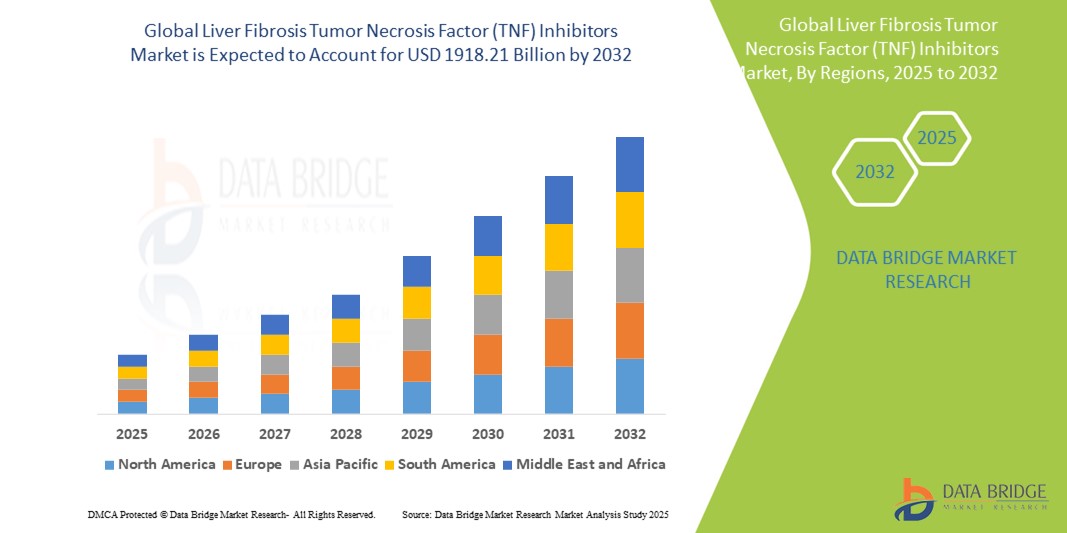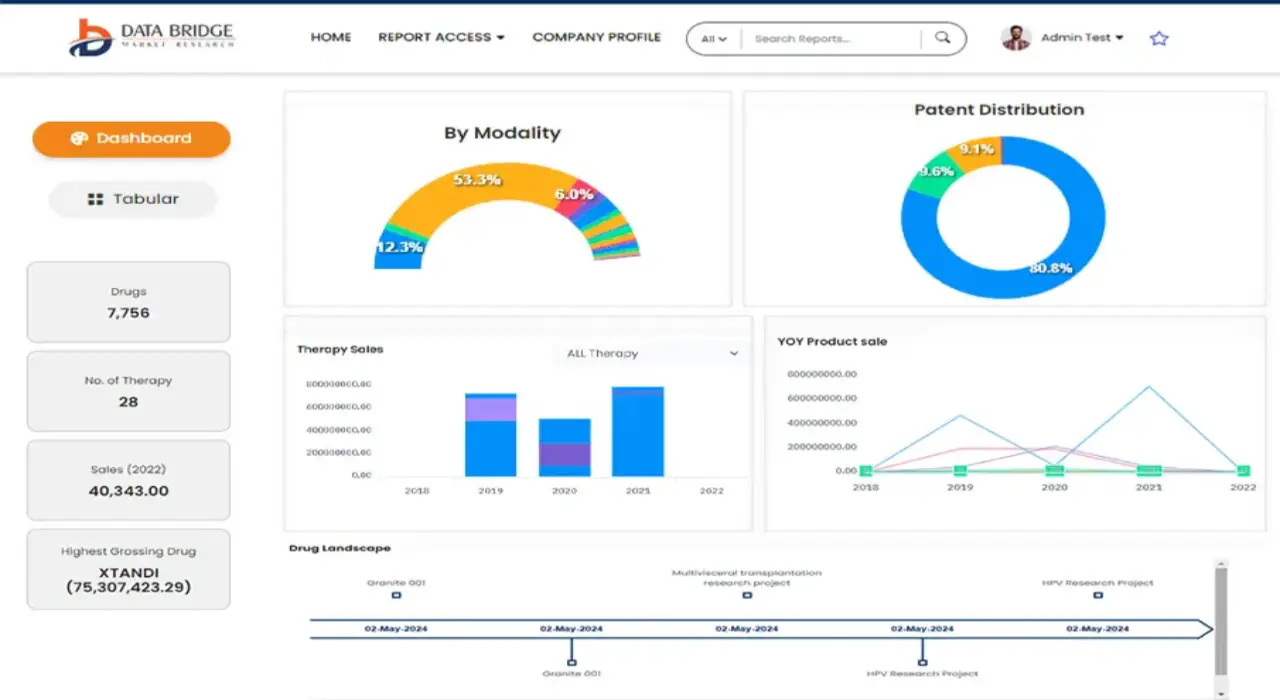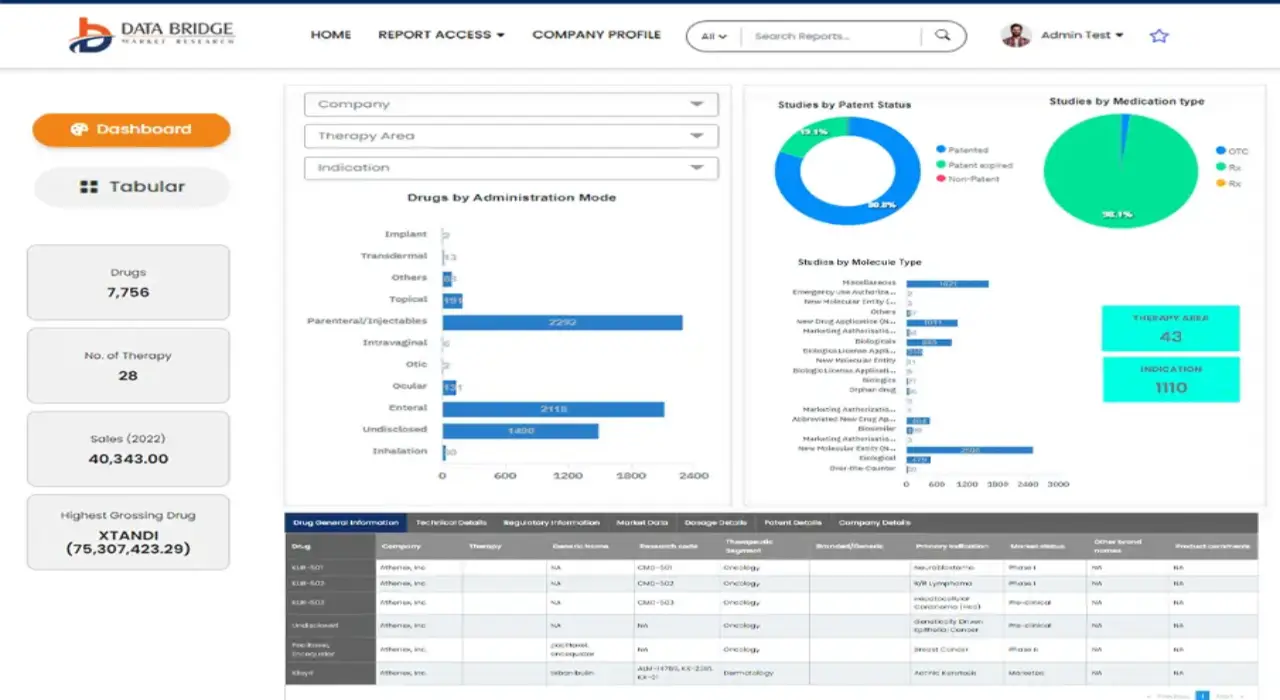Global Liver Fibrosis Tumor Necrosis Factor Tnf Inhibitors
Market Size in USD Million
CAGR :
% 
 USD
825.20 Million
USD
1,918.21 Million
2024
2032
USD
825.20 Million
USD
1,918.21 Million
2024
2032
| 2025 –2032 | |
| USD 825.20 Million | |
| USD 1,918.21 Million | |
|
|
|
|
Global Liver Fibrosis Tumor Necrosis Factor (TNF) Inhibitors Market Segmentation, By TNFα Type (Infliximab, Etanercept, Adalimumab, Glomumab, and Certolizumab Pegol), Disease Type (Hepatitis, Autoimmune Diseases, Non-alcoholic Fatty Liver Disease (NAFLD), Cancer, Genetic Disorders, and Others), Route of Administration (Oral, Intravenous, Intramuscular, and Others), End User (Hospitals, Specialty Clinics, and Others) - Industry Trends and Forecast to 2032
Liver Fibrosis Tumor Necrosis Factor (TNF) Inhibitors Market Size
- The global liver fibrosis tumor necrosis factor (TNF) inhibitors market was valued at USD 825.2 million in 2024 and is expected to reach USD 1918.21 million by 2032
- During the forecast period of 2025 to 2032 the market is likely to grow at a CAGR of 11.12%, primarily driven by the rising liver disease prevalence globally
- This growth is driven by factors such as rising prevalence of chronic liver diseases and growing focus on anti-inflammatory therapeutics in liver care
Liver Fibrosis Tumor Necrosis Factor (TNF) Inhibitors Market Analysis
- Liver Fibrosis Tumor Necrosis Factor (TNF) Inhibitors are therapeutic agents designed to block the activity of TNF-α, a pro-inflammatory cytokine implicated in the progression of liver fibrosis. Liver fibrosis occurs when chronic liver injury leads to excessive accumulation of extracellular matrix proteins, eventually impairing liver function and potentially progressing to cirrhosis
- The global liver fibrosis TNF inhibitors market is experiencing notable growth, projected to expand at a CAGR of 11.12% in the coming years. This growth is primarily driven by the rising prevalence of chronic liver diseases such as hepatitis B and C, non-alcoholic steatohepatitis (NASH), and alcohol-induced liver damage. Inflammatory pathways, especially those involving TNF-α, play a crucial role in the fibrogenesis process, making TNF inhibitors an important therapeutic avenue to slow disease progression and improve patient outcomes
- In addition, increasing investments in clinical trials and research for anti-fibrotic therapies are fueling market expansion. Advances in biologics and the development of biosimilar TNF inhibitors are expected to enhance treatment accessibility. However, the market still faces challenges, including high treatment costs and potential side effects
- North America currently dominates the market, but Asia-Pacific is anticipated to witness the fastest growth due to rising healthcare awareness and increasing incidence of liver-related disorders
Report Scope and Liver Fibrosis Tumor Necrosis Factor (TNF) Inhibitors Market Segmentation
|
Attributes |
Liver Fibrosis Tumor Necrosis Factor (TNF) Inhibitors Key Market Insights |
|
Segments Covered |
|
|
Countries Covered |
North America
Europe
Asia-Pacific
Middle East and Africa
South America
|
|
Key Market Players |
|
|
Market Opportunities |
|
|
Value Added Data Infosets |
In addition to the insights on market scenarios such as market value, growth rate, segmentation, geographical coverage, and major players, the market reports curated by the Data Bridge Market Research also include depth expert analysis, patient epidemiology, pipeline analysis, pricing analysis, and regulatory framework. |
Liver Fibrosis Tumor Necrosis Factor (TNF) Inhibitors Market Trends
Increasing Focus on Combination Therapies
- One key trend in the liver fibrosis tumor necrosis factor (TNF) inhibitors market is the increasing focus on combination therapies
- Researchers and pharmaceutical companies are exploring the potential of combining TNF inhibitors with other anti-fibrotic or anti-inflammatory agents to enhance therapeutic efficacy. Since liver fibrosis involves multiple complex pathways beyond TNF-α, combination approaches aim to target several mechanisms simultaneously, offering a more comprehensive treatment strategy
- This trend is particularly significant in managing advanced fibrosis stages and conditions such as NASH, where inflammation, metabolic dysfunction, and fibrosis co-exist. Ongoing clinical trials are evaluating how TNF inhibitors can synergize with agents targeting TGF-β, PDGF, or metabolic modulators to slow fibrosis progression effectively
- If successful, these combination therapies could improve patient outcomes and broaden the application of TNF inhibitors in liver care. Moreover, this trend aligns with the overall move towards personalized medicine, addressing individual patient profiles for better disease management
Liver Fibrosis Tumor Necrosis Factor (TNF) Inhibitors Market Dynamics
Driver
Rising Prevalence of Chronic Liver Diseases
- The rising prevalence of chronic liver diseases such as hepatitis B and C, non-alcoholic steatohepatitis (NASH), and alcoholic liver disease is significantly contributing to the increased demand for liver fibrosis tumor necrosis factor (TNF) inhibitors
- As the global population ages and lifestyle-related risk factors such as obesity, diabetes, and excessive alcohol consumption continue to rise, the incidence of liver fibrosis is growing worldwide, creating a greater need for effective anti-inflammatory therapies
- NASH, in particular, is rapidly becoming a major cause of liver fibrosis, especially in developed regions, necessitating advanced treatments such as TNF inhibitors that can target the inflammatory pathways driving disease progression
- The ongoing advancements in biotechnology and immunology further highlight the potential of TNF inhibitors, as they effectively block the pro-inflammatory cytokine TNF-α, which plays a crucial role in promoting liver fibrosis
- As more individuals seek timely and effective treatments to prevent the progression of liver fibrosis to severe stages such as cirrhosis and hepatocellular carcinoma, the demand for TNF inhibitors rises, offering a promising approach to improving patient outcomes and reducing liver-related mortality
For instance,
- In June 2023, according to an article published by the National Center for Biotechnology Information, the global prevalence of non-alcoholic fatty liver disease (NAFLD), a precursor to liver fibrosis, was estimated at around 32.4%, highlighting the urgent need for targeted therapies to manage and prevent fibrosis progression
- In September 2022, according to the World Health Organization (WHO), viral hepatitis affects over 350 million people globally, with chronic hepatitis B and C infections being leading contributors to liver fibrosis, thereby driving demand for effective TNF inhibitor treatments
- As a result of the rising prevalence of chronic liver diseases and the increasing focus on early intervention, there is a significant increase in the demand for liver fibrosis tumor necrosis factor (TNF) inhibitors
Opportunity
Advancing Ophthalmology with Artificial Intelligence Integration
- The development of advanced biologics and biosimilars offers significant opportunities to expand access to liver fibrosis tumor necrosis factor (TNF) inhibitors, making treatments more affordable and widely available
- Biologic TNF inhibitors have demonstrated strong efficacy in targeting inflammation pathways in liver fibrosis, and the introduction of biosimilars can provide comparable therapeutic benefits at a reduced cost, helping to alleviate the financial burden on healthcare systems and patients
- In addition, the increasing focus on personalized medicine and biomarker-based therapies is creating opportunities to tailor TNF inhibitor treatments according to individual patient profiles, enhancing treatment efficacy and minimizing adverse effects
For instance,
- In October 2023, according to an article published in the Journal of Hepatology, advancements in biomarker discovery for liver fibrosis are enabling early identification of patients who are most likely to respond to TNF inhibitor therapies, paving the way for more targeted and effective treatment strategies
- In August 2022, according to research by the National Center for Biotechnology Information, the introduction of cost-effective biosimilars for TNF inhibitors is improving access to critical therapies in emerging markets, where liver disease prevalence is high but healthcare spending is limited
- The integration of advanced biologics and biosimilars in the liver fibrosis treatment landscape can also lead to improved patient outcomes, expanded treatment accessibility, and reduced disease burden worldwide. By leveraging these innovations, healthcare providers can proactively manage liver fibrosis and slow disease progression effectively
Restraint/Challenge
High Equipment Costs Hindering Market Penetration
- The high development and treatment costs associated with liver fibrosis tumor necrosis factor (TNF) inhibitors pose a significant challenge for the market, particularly impacting patient accessibility and healthcare system affordability
- TNF inhibitors, being advanced biologic therapies, often come with substantial price tags, which can exceed several thousand dollars per treatment cycle, creating financial burdens for both patients and healthcare providers
- This considerable economic barrier restricts widespread adoption, especially in low- and middle-income countries, where healthcare budgets are limited and insurance coverage for expensive biologics remains insufficient
For instance,
- In December 2023, according to an article published by the National Center for Biotechnology Information, the annual cost of TNF inhibitor therapies in the U.S. ranges between USD 15,000 and USD 25,000 per patient, making these treatments less accessible to uninsured or underinsured populations and raising concerns about healthcare equity
- Consequently, such high treatment costs can lead to disparities in patient access to effective liver fibrosis therapies, delaying timely intervention and increasing the risk of disease progression to more severe stages such as cirrhosis or liver cancer. This ultimately hampers the broader growth potential of the global liver fibrosis TNF inhibitors market
Liver Fibrosis Tumor Necrosis Factor (TNF) Inhibitors Market Scope
The market is segmented on the basis of TNFα type, disease type, route of administration, and end user.
|
Segmentation |
Sub-Segmentation |
|
By TNFα Type |
|
|
By Disease Type |
|
|
By Route of Administration |
|
|
By End User |
|
Liver Fibrosis Tumor Necrosis Factor (TNF) Inhibitors Market Regional Analysis
North America is the Dominant Region in the Liver Fibrosis Tumor Necrosis Factor (TNF) Inhibitors Market
- North America is the dominant region in the liver fibrosis tumor necrosis factor (TNF) inhibitors market. This dominance is primarily attributed to the high prevalence of chronic liver diseases, robust healthcare infrastructure, and substantial investments in advanced biologic therapies
- U.S. in particular, accounts for a significant market share due to its well-established pharmaceutical sector, strong focus on research and development, and early adoption of innovative treatments
- In addition, favorable reimbursement policies and widespread awareness regarding liver fibrosis and associated therapies further support market growth in the region. According to recent studies, increasing incidences of non-alcoholic steatohepatitis (NASH) and hepatitis-related liver conditions have escalated the demand for effective anti-inflammatory solutions, such as TNF inhibitors
- The presence of leading biotech companies and ongoing clinical trials for advanced therapeutics continues to reinforce North America's leadership position in this market, making it the most lucrative region globally
Asia-Pacific is Projected to Register the Highest Growth Rate
- Asia-Pacific is projected to register the highest growth rate in the liver fibrosis tumor necrosis factor (TNF) inhibitors market. Rapidly increasing prevalence of liver diseases, such as hepatitis B and C, non-alcoholic fatty liver disease (NAFLD), and rising alcohol consumption are major factors driving this growth
- Countries such as China, India, and Japan are witnessing a surge in liver fibrosis cases, fueled by changing lifestyles and aging populations. In addition, growing healthcare expenditure, improving access to advanced biologic therapies, and supportive government initiatives are enhancing early diagnosis and treatment rates in the region
- Furthermore, pharmaceutical companies are expanding their presence and clinical research activities in Asia-Pacific, aiming to tap into this high-potential market. Collectively, these factors are expected to position Asia-Pacific as the fastest-growing region in the forecast period
- China is projected to register the highest growth rate in the liver fibrosis tumor necrosis factor (TNF) inhibitors market, driven by rising liver disease prevalence, healthcare investments, and expanding access to biologic therapies
Liver Fibrosis Tumor Necrosis Factor (TNF) Inhibitors Market Share
The market competitive landscape provides details by competitor. Details included are company overview, company financials, revenue generated, market potential, investment in research and development, new market initiatives, global presence, production sites and facilities, production capacities, company strengths and weaknesses, product launch, product width and breadth, application dominance. The above data points provided are only related to the companies' focus related to market.
The Major Market Leaders Operating in the Market Are:
- Boehringer Ingelheim International GmbH (Germany)
- Gilead Sciences, Inc. (U.S.)
- Gyre Therapeutics, Inc. (U.S.)
- Galectin Therapeutics Inc. (U.S.)
- Hepion Pharmaceuticals (U.S.)
- Intercept Pharmaceuticals, Inc. (U.S.)
- Ionis Pharmaceuticals (U.S.)
- Inventiva (France)
- Lilly (U.S.)
- Madrigal Pharmaceuticals (U.S.)
- Merck & Co., Inc. (U.S.)
- Novo Nordisk A/S (Denmark)
- Novartis AG (Switzerland)
- Pfizer Inc. (U.S.)
- Pharmaxis Group USA (U.S.)
- Rivus Pharmaceuticals (U.S.)
- Torrent Pharmaceuticals Ltd. (India)
- VBShilpa (India)
- ZEALAND PHARMA (Denmark)
- Zydus Group (India)
SKU-
Get online access to the report on the World's First Market Intelligence Cloud
- Interactive Data Analysis Dashboard
- Company Analysis Dashboard for high growth potential opportunities
- Research Analyst Access for customization & queries
- Competitor Analysis with Interactive dashboard
- Latest News, Updates & Trend analysis
- Harness the Power of Benchmark Analysis for Comprehensive Competitor Tracking
Research Methodology
Data collection and base year analysis are done using data collection modules with large sample sizes. The stage includes obtaining market information or related data through various sources and strategies. It includes examining and planning all the data acquired from the past in advance. It likewise envelops the examination of information inconsistencies seen across different information sources. The market data is analysed and estimated using market statistical and coherent models. Also, market share analysis and key trend analysis are the major success factors in the market report. To know more, please request an analyst call or drop down your inquiry.
The key research methodology used by DBMR research team is data triangulation which involves data mining, analysis of the impact of data variables on the market and primary (industry expert) validation. Data models include Vendor Positioning Grid, Market Time Line Analysis, Market Overview and Guide, Company Positioning Grid, Patent Analysis, Pricing Analysis, Company Market Share Analysis, Standards of Measurement, Global versus Regional and Vendor Share Analysis. To know more about the research methodology, drop in an inquiry to speak to our industry experts.
Customization Available
Data Bridge Market Research is a leader in advanced formative research. We take pride in servicing our existing and new customers with data and analysis that match and suits their goal. The report can be customized to include price trend analysis of target brands understanding the market for additional countries (ask for the list of countries), clinical trial results data, literature review, refurbished market and product base analysis. Market analysis of target competitors can be analyzed from technology-based analysis to market portfolio strategies. We can add as many competitors that you require data about in the format and data style you are looking for. Our team of analysts can also provide you data in crude raw excel files pivot tables (Fact book) or can assist you in creating presentations from the data sets available in the report.













